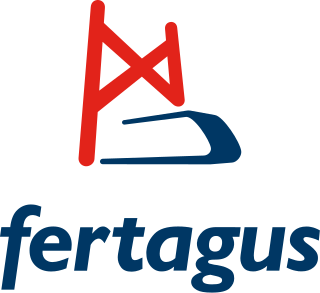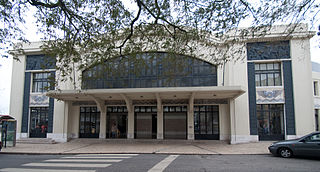
Seixal is a Portuguese city and municipality, located in the district of Setúbal, in the metropolitan area of Lisbon. Its population includes 184,269 inhabitants (2011), in an area of 93.58 square kilometres (36.13 sq mi) that includes six parishes. It is situated across the Tagus River estuary from Lisbon. Its seat is the city of Seixal, a centre of 31,600 inhabitants situated along the Rio Judeu.

Almada is a city and a municipality in Portugal, located on the southern margin of the Tagus River, on the opposite side of the river from Lisbon. The two cities are connected by the 25 de Abril Bridge. The population of the municipality in 2011 was 174,030, in an area of 70.21 km2. The urbanized core center, the city of Almada proper, had a population of 101,500 in 2001. It makes part of the Lisbon Metropolitan Area.

The Lisbon Metro is a rapid transit system in Lisbon, Portugal. Opened in December 1959, it was the first rapid transit system in Portugal, and to date is the only rapid transit system in Portugal. As of 2023, the system's four lines total 44.5 kilometres (27.7 mi) of route and serve 56 stations.

The Porto Metro is a light rail network in Porto, Portugal and a key part of the city's public transport system. Being a semi-metro, it runs underground in central Porto and above ground into the city's suburbs using low-floor tram vehicles. The first parts of the system have been in operation since 2002. It is a separate system to Porto's vintage trams.

The Rio de Janeiro Metro, commonly referred to as just the Metrô is a rapid transit network that serves the city of Rio de Janeiro, Brazil. The Metrô was inaugurated on 5 March 1979, and consisted of five stations operating on a single line. The system currently covers a total of 58 kilometres (36 mi), serving 41 stations, divided into three lines: Line 1 ; Line 2, which together travel over a shared stretch of line that covers 10 stations of an approximate distance of 5 kilometres (3.1 mi); and Line 4. Metrô Rio has the second highest passenger volume of the metro systems in Brazil, after the São Paulo Metro.

REFER, Rede Ferroviária Nacional, EP was the Portuguese rail infrastructure manager. It was a state-owned company and was created to manage the Portuguese rail infrastructure, previously under control of CP, which became exclusively a train service operator.

The Federal District Metro is the rapid transit system of the Federal District, in Brazil. It is operated by Companhia do Metropolitano do Distrito Federal and was opened in 2001. Currently, Federal District's Metro has 27 stations on two lines, and it runs for 42.38 kilometers (26.33 mi). The system passes through 6 Administrative regions of the Federal District, those being Brasília, Guará, Águas Claras, Taguatinga, Ceilândia, and Samambaia.

Cacilhas is a former civil parish in the municipality of Almada, Lisbon metropolitan area, Portugal. In 2013, the parish merged into the new parish Almada, Cova da Piedade, Pragal e Cacilhas. The population in 2011 was 6,017, in an area of 1.09 km2. Cacilhas is situated on the south bank of the river Tagus facing the city of Lisbon.

Cruz de Pau is a locality in the parish of Amora, in the municipality of Seixal in Portugal. It is part of the Lisbon metropolitan area. It is served by the suburban train Fertagus station of Foros de Amora and the bus company TST, Transportes Sul do Tejo that links the locality both to Lisbon (15mins) and Setúbal (35mins) city centres.

Fertagus is a commuter rail operator connecting Lisbon, Portugal's capital, to suburbs on the Setúbal Peninsula, located to the south across the Tagus River. Fertagus crosses the river over the Ponte 25 de Abril.

The Tidal Mill of Corroios is a 15th-century pluvial mill situated in the civil parish of Corroios, municipality of Seixal.

Amora is a civil parish, in the municipality of Seixal in the district of Setúbal, Portugal. It is part of the Lisbon metropolitan area. The population in 2011 was 48,629, in an area of 24.36 km2.

The Metropolitan of Fortaleza, also known popularly as Metro of Fortaleza or Metrofor, is a system of metropolitan transport that operates in the Brazilian city of Fortaleza, operated by Companhia Cearense de Transportes Metropolitanos, company of social capital, captained by the Government of the State of Ceará, in Brazil, and has as current president Eduardo Hotz. Founded on May 2, 1997, the company is responsible for administration, construction and metro planning in the state of Ceará, being present in the systems of Sobral and Cariri, having its main activity in Fortaleza and its metropolitan region.

The Cais do Sodré Railway Station is an intermodal railway station in the civil parish of Misericórdia, in the municipality of Lisbon, serving as the terminus of the suburban route to the resort town Cascais.

The Metro Mondego, part of the mass transit public transport system of Coimbra, Portugal, was to have been a light-rail network that runs above ground in Coimbra into the city's suburbs. Studies and planning were in progress but the Metro Mondego project was cancelled in January 2011 at the height of Portuguese financial crisis. The operational conventional rail line connecting the municipalities of: Coimbra, Miranda do Corvo, Lousã, and Serpins was closed at the same time and replaced by a bus service.

The Lisbon tramway network is a system of trams that serves Lisbon, the capital city of Portugal. In operation since 1873, it presently comprises six lines. The system has a length of 31 km, and 63 trams in operation. The depot is located in Santo Amaro, in Alcântara.

The history of rail transport in Portugal dates from 28 October 1856, when Portugal's first railway line was opened between Lisbon and Carregado: the Companhia dos Caminhos de Ferro Portugueses.

Areeiro is a station on the Green Line of the Lisbon Metro serving the Areeiro neighbourhood. The station is located in the Praça Francisco Sá Carneiro, just south of the Roma-Areeiro railway station.

Cais do Sodré is a station on the Green Line of the Lisbon Metro. It is located in the Praça Duque da Terceira, connecting to the Cais do Sodré railway station and a boat port.





















